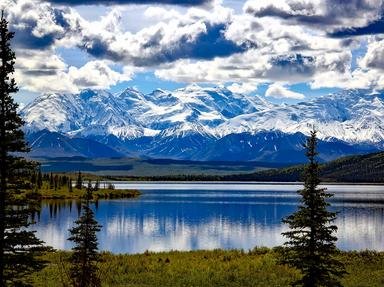Quiz Answer Key and Fun Facts
1. While gambling is not allowed in most cases in Alaska (gaming for charitable organizations and Native corporations being the principle exceptions), there is one gaming event that attracts special attention. Every winter since the early 1900s, people have been invited to take part in the Nenana Ice Classic, in which one may buy a ticket to guess the date and time on which a buoy will move a specified distance downstream on an interior Alaska river during the ice's breakup. Which river is this?
2. This is the longest river in Alaska.
3. This river, found in southcentral Alaska, is one of the state's best known as a result of its world class salmon fishing. In fact, the world's largest sport caught Chinook (King) salmon was landed in this river.
4. North of Anchorage is a region known as the Mat-Su Valley. When the state was settled during the Great Depression (primarily with people from Minnesota, Wisconsin, and the Dakotas), this is where they primarily came. The towns of Wasilla, Palmer, Sutton, and Talkeetna are found in this region. From which two rivers does this region derive its name?
(Mat-Su is *not* the official name, it is however the most commonly used name and a shortened version of the official name. The official name is actually the full name of the two rivers and would make the question somewhat trivial!)
5. One of the major drainages flowing into Prince William Sound, this river includes tributaries such as the Tonsina River, itself a large river. Home to large runs of all species of Pacific salmon, this river is known in the state for the subsistence fishing (by dipnet) which is allowed in it every summer. If you were to stand atop Mount St. Elias (an impressive feat), you could look down on this river.
6. There are two principle sources for rivers in the state: glaciers and run-off. While many rivers contain water from both sources (in fact there is no such thing as a "pure" glacial river, all rivers have at least some runoff), they tend to be different enough to be clearly distinguishable. Which of the following rivers is NOT a glacial river?
7. The Klondike Gold Rush had its golden Centennial in the 1998-1999 period, attracting a lot of attention to southeast Alaska (the panhandle). The gold rushers made landfall on their way to the Klondike fields in the towns of Skagway (now a tiny town of less than 1,000 and popular cruise ship stop in the summers) and Dyea (now a ghost town.) Both of these towns, which had a combined population of over 100,000 people at the turn of the century, lie along the Lynn Canal. What is the main river that drains into Lynn Canal?
8. One of the state's largest rivers, this one comes within 50 miles of Alaska's largest river at one point. Together with the state's largest river, this river creates a massive river delta region in southwest Alaska. 650 miles long, it eventually flows into Goodnews Bay.
9. This is the largest river north of the Brooks Range (a region known as the 'North Slope' and the locus of most of the state's oil production.)
10. Which of these rivers is NOT crossed on the Iditraod Trail Sleddog Race?
Source: Author
Lonagan
This quiz was reviewed by FunTrivia editor
LilahDeDah before going online.
Any errors found in FunTrivia content are routinely corrected through our feedback system.

